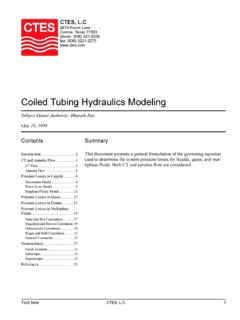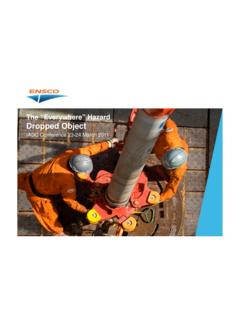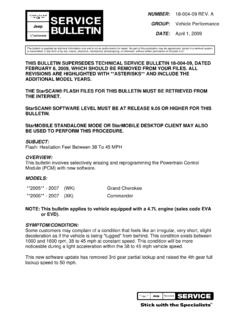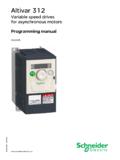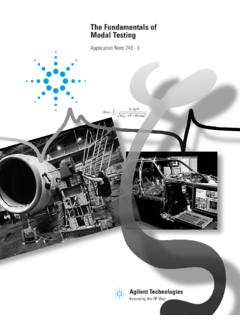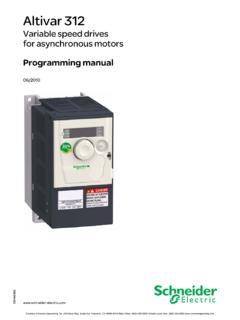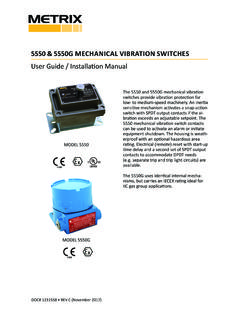Transcription of Product Information - ТРИГЛА
1 August 2007 Product InformationERM 200 SeriesModular Magnetic EncodersProduct Information ERM 200 8/20072 Range of ApplicationsThe robust ERM modular magnetic encoders are especially suited for use in production large possible inside diameters as well as the small dimensions and compact design of the scanning head predestine them for:The C axis of lathesSpindle orientation on milling machinesAuxiliary axesIntegration in gear stagesThe signal period of approx. 400 m and the special MAGNODUR procedure for applying the grating achieve the accuracies and shaft speeds required by these applications. Shaft speedsThe ERM circumferential-scale drums can operate at high shaft speeds. Ancillary noises, such as from gear-tooth systems, do not occur. The maximum shaft speeds listed in the specifi cations (up to 19 000 min 1) suffi ce for most typical application for ERM 200 encoders is on the C axis of lathes, especially for the machining of bar-stock material.
2 Here the graduation of the ERM modular encoder is usually on a diameter that is approximately twice as large as the workpiece to be machined. The accuracy and reproducibility of the ERM also achieve suffi cient workpiece accuracies for milling operations with lathes (classical C-axis machining).Example:Accuracy of a workpiece from bar-stock material, 100-mm diameter;ERM 280 encoder on C axis withAccuracy: 12 with 2048 linesDrum outside diameter: mm = tan12 x radius = mCalculated position error: mConclusion:For bar-stock material with a diameter of 100 mm, the maximum position error that can result from the encoder is less than 3 m. Eccentricity errors must also be considered, but these can be reduced through accurate mounting. C-axis machiningProduct Information ERM 200 8/20073 Measuring PrincipleMeasuring standardHEIDENHAIN encoders incorporate measuring standards of periodic structures known as encoders use a graduation carrier of magnetizable steel alloy.
3 A write head applies strong local magnetic fi elds in different directions, so that a graduation consisting of north poles and south poles is formed with a signal period of 400 m (MAGNODUR process). Due to the short distance of effect of electromagnetic interaction, and the very narrow scanning gaps required, fi ner magnetic graduations are not scanning principleMeasuring standardScanning reticleMagnetoresistive sensors for B+ and B not shownMagnetic scanningThe permanently magnetic MAGNODUR graduation is scanned by magnetoresistive sensors, whose resistances change in response to a magnetic fi eld. When a voltage is applied to the sensor and the scale drum moves relative to the scanning head, the fl owing current is modulated according to the magnetic fi special geometric arrangement of the resistive sensors and the manufacture of the sensors on glass substrates ensure a high signal quality.
4 In addition, the large scanning surface allows the signals to be fi ltered for harmonic waves. These are prerequisites for minimizing position errors within one signal structure on a separate track produces a reference mark signal. This makes it possible to assign this absolute position value to exactly one measuring scanning is used primarily for comparatively low-accuracy applications, or for applications where the machined parts are relatively small compared to the scale measuring methodWith the incremental measuring method, the graduation consists of a periodic grating structure. The position Information is obtained by counting the individual increments (measuring steps) from some point of origin. The shaft speed is determined through mathematic derivation of the change in position over an absolute reference is required to ascertain positions, the scale drums are provided with an additional track that bears a reference mark.
5 The absolute position on the scale, established by the reference mark, is gated with exactly one measuring step. The reference mark must therefore be scanned to establish an absolute reference or to fi nd the last selected Information ERM 200 8/20074 Measuring AccuracyThe accuracy of angular measurement is mainly determined by:The quality of the graduationThe quality of the scanning processThe quality of the signal processing electronicsThe eccentricity of the graduation to the bearingThe error of the bearingThe coupling to the measured shaftThe system accuracy given in the Specifi cations is defi ned as follows:The system accuracy refl ects position error within one revolution as well as that within one signal period. The extreme values of the total deviations of a position are within the system accuracy encoders without integral bearing, additional deviations resulting from mounting, errors in the bearing of the drive shaft, and adjustment of the scanning head must be expected.
6 These deviations are not refl ected in the system accuracy. Position errors within one revolution become apparent in larger angular errors within one signal period already become apparent in very small angular motions and in repeated measurements. They especially lead to speed ripples in the speed control loop. These deviations within one signal period are caused by the quality of the sinusoidal scanning signals and their subdivision. The following factors infl uence the result:The size of the signal period,The homogeneity and period defi nition of the graduation,The quality of scanning fi lter structures,The characteristics of the detectors, andThe stability and dynamics during the further processing of the analog signals. HEIDENHAIN encoders take these factors of infl uence into account, and permit interpolation of the sinusoidal output signal with typical subdivision accuracies of better than 1% of the signal , the 400- m signal periods of ERM modular magnetic encoders are relatively large.
7 Angle encoders using the photoelectric scanning principle are better suited for higher accuracy requirements: Along with their better system accuracy, they also feature signifi cantly smaller signal periods (typically 20 m), and therefore have correspondingly smaller position errors within one signal errors within one revolutionPosition error within one signal periodPosition fPosition error within one signal periodPosition error fPosition error fSignal level fSignal period360 elec. Product Information ERM 200 8/20075In addition to the system accuracy, the mounting and adjustment of the scanning head and of the scale drum normally have a signifi cant effect on the accuracy that can be achieved with encoders without integral bearings. Of special importance are the mounting eccentricity and radial runout of the drive order to evaluate the total accuracy, each of the signifi cant errors must be considered Directional deviations of the graduationThe extreme values of the directional deviation with respect to their mean value are shown in the Specifi cations as the graduation accuracy.
8 The graduation accuracy and the position error within a signal period comprise the system Error due to eccentricity of the graduation to the bearingUnder normal circumstances, the graduation will have a certain eccentricity relative to the bearing once the ERM s scale drum is mounted. In addition, dimensional and form deviations of the shaft can result in added following relationship exists between the eccentricity e, the graduation diameter D and the measuring error (see illustration below): = 412 e = Measuring error in (angular seconds)e = Eccentricity of the radial grating to the bearing in m (1/2 the radial deviation)D = Scale-drum diameter (= drum outside diameter) in mmM = Center of graduation = True angle = Scanned angleDEccentricity of the graduation to the bearingScanning unit3. Error due to radial deviation of the bearingThe equation for the measuring error is also valid for radial deviation of the bearing if the value e is replaced with the eccentricity value, half of the radial deviation (half of the displayed value).
9 Bearing compliance to radial shaft loading causes similar Position error within one signal period uThe scanning units of all HEIDENHAIN encoders are adjusted so that the maximum position error values within one signal period will not exceed the values listed below, with no further electrical adjusting required at countPosition error within one signal period u360026002 048140012001 024 900 600 5 6 7 11 12 13 15 22 The values for the position errors within one signal period are already included in the system accuracy. Larger errors can occur if the mounting tolerances are diameter DError per 1 m of eccentricityD = 75 mmD = 113 mmD = 130 mmD = 150 mmD = 176 mmD = 260 mmD = 327 mmD = 453 mm Resultant measured deviations for various eccentricity values e as a function of graduation diameter DError [angular seconds] Graduation diameter D [mm] Product Information ERM 200 8/20076 Mounting InstructionsSystem testsEncoders from HEIDENHAIN are usually integrated as components in larger systems.
10 Such applications require comprehensive tests of the entire system regardless of the specifi cations of the specifi cations given in the brochure apply to the specifi c encoder, not to the complete system. Any operation of the encoder outside of the specifi ed range or for any other than the intended applications is at the user s own safety-oriented systems, the higher-level system must verify the position value of the encoder after steps to be performed and dimensions to be maintained during mounting are specifi ed solely in the mounting instructions supplied with the unit. All data in this catalog regarding mounting are therefore provisional and not binding; they do not become terms of a ERM modular encoders consist of a circumferential scale drum and the corresponding scanning head. Special design features assure comparatively fast mounting and easy circumferential scale drum is slid onto the drive shaft and fastened with screws.


